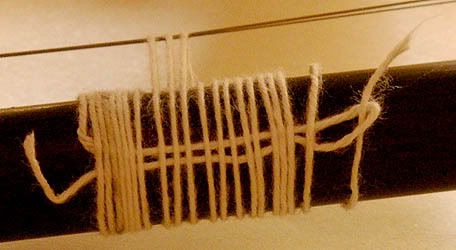
The photo should make it clear how you do it, you then pull the end of the string on the left. Obviously when you actually do it, you wrap the string tightly around the neck without any spaces in between the windings. The photo shows a 150cm string, with 8 windings around the neck, then 3 around the neck and strings, then finally 8 around the neck again. The string is the string used to seal 10kg and 25kg bags of rice!
In my opinion, you should not have too many windings around the neck and erhu strings. In theory, if you had a unbreakable qianjin string, you would only have 1 winding because the contact area where the qianjin and erhu strings meet should be clear and sharp as possible, at least on the vibrating side of the strings. I use 3 and it seems to be strong enough.
A variation of this method is to use 2 pieces of string: the main length and a separate short elongated "U" bit. Actually this is better because both ends of the string on the finished qianjin will be completely hidden under the windings, whereas if you use the 1 string method in the photo, you have to cut off the last bit of string.
A further refinement maybe is to dampen the string, when it's dried it should end up tighter on the neck, although I haven't tried it.
The photo is not a square on side view of the neck, so the erhu strings appear to be closer to the neck than they actually are.
No comments:
Post a Comment